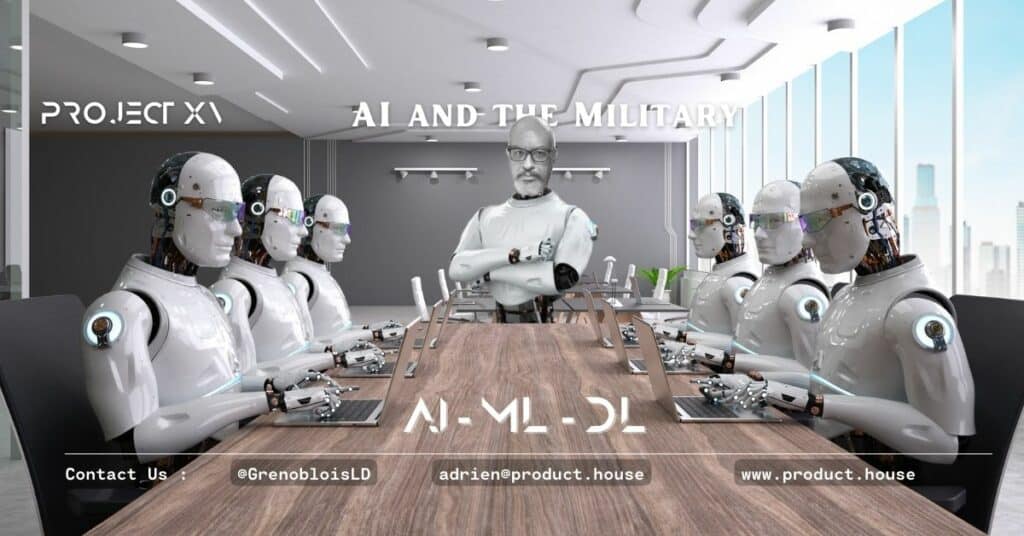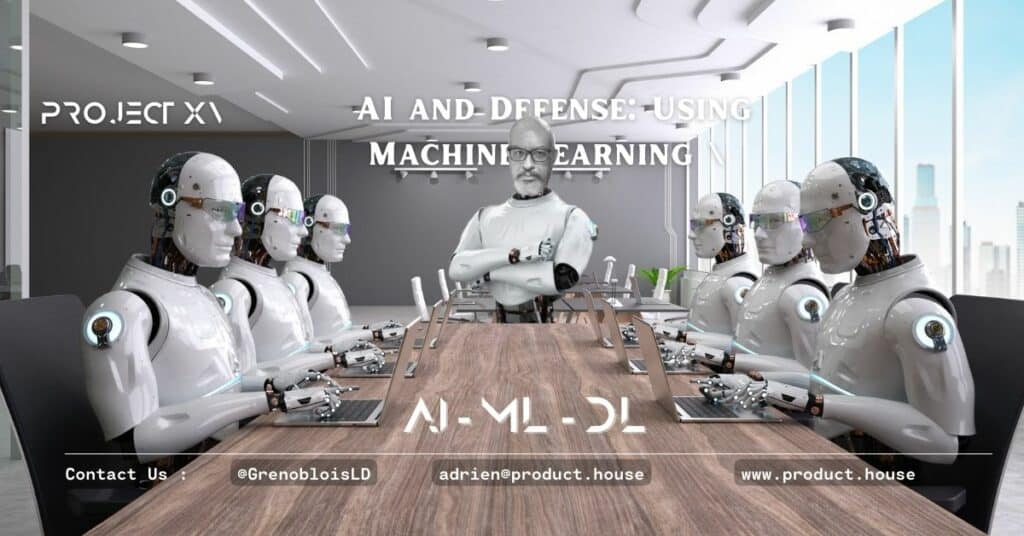AI and Military Robotics: Improving Efficiency and Reducing Risk to Soldiers

The use of artificial intelligence (AI) and robotics in the military has revolutionized the way wars are fought. Military robots equipped with AI have been used to increase efficiency, minimize risk to soldiers, and complete complex tasks that would be difficult for humans to perform. In this article, we will explore the applications of AI and robotics in the military, their benefits and challenges, and the potential implications for the future of warfare.
Applications of AI and Robotics in the Military
The use of AI and robotics in the military has a wide range of applications, including reconnaissance, surveillance, bomb disposal, and logistics. For example, unmanned aerial vehicles (UAVs), or drones, equipped with AI technology can be used to conduct aerial reconnaissance and surveillance without risking the lives of pilots. Additionally, ground-based robots equipped with AI can be used to detect and dispose of explosive devices, reducing the risk to human bomb disposal teams.
Benefits of AI and Robotics in the Military
One of the main benefits of AI and robotics in the military is their ability to increase efficiency and effectiveness in completing tasks. These technologies can operate around the clock, without the need for rest or breaks, and can complete repetitive or dangerous tasks that would be difficult or impossible for humans to perform. Additionally, the use of military robots equipped with AI can significantly reduce the risk to soldiers in dangerous situations.
Challenges of AI and Robotics in the Military
While the use of AI and robotics in the military offers many benefits, it also poses several challenges. One of the main challenges is the potential for unintended consequences or the misuse of these technologies. Additionally, there are concerns about the potential for AI and robotics to replace human soldiers, leading to ethical concerns related to the use of force.
Implications for Future Warfare
The integration of AI and robotics into military operations has the potential to significantly change the nature of warfare. The use of unmanned systems, for example, could lead to a shift in the role of soldiers in combat and raise ethical concerns related to the use of force. Additionally, the potential for AI and robotics systems to malfunction or be hacked raises concerns about the unintended consequences of these technologies in military operations.
Conclusion
The use of AI and robotics in the military has revolutionized the way wars are fought, offering significant benefits but also raising ethical concerns and challenges related to accountability and unintended consequences. As these technologies continue to be integrated into military operations, it is essential to carefully consider their implications for the future of warfare.
FAQs:
- What are some applications of AI and robotics in the military?
AI and robotics are being used in various aspects of military operations, including reconnaissance, surveillance, bomb disposal, and logistics.
- What are the benefits of AI and robotics in the military?
The benefits of AI and robotics in the military include increased efficiency and effectiveness in completing tasks, reduced risk to soldiers in dangerous situations, and the ability to operate around the clock without the need for rest or breaks.
- What are some challenges of using AI and robotics in the military?
Challenges of AI and robotics in the military include the potential for unintended consequences or misuse of these technologies, and ethical concerns related to the use of force and the potential for replacing human soldiers.
- How can the potential for unintended consequences or misuse of AI and robotics be addressed in military applications?
The potential for unintended consequences or misuse of AI and robotics in military applications can be addressed through careful development, testing, and evaluation of these technologies, as well as ongoing monitoring and regulation to ensure their ethical use. - What is the potential for AI and robotics to change the nature of warfare?
The integration of AI and robotics into military operations has the potential to significantly change the nature of warfare, potentially leading to a shift in the role of soldiers and raising ethical concerns related to the use of force. - Can AI and robotics replace human soldiers in military operations?
While AI and robotics can complete certain tasks more efficiently and with less risk than human soldiers, they cannot replace the complex decision-making and adaptability of human soldiers in combat. - What are some examples of military robots equipped with AI?
Examples of military robots equipped with AI include unmanned aerial vehicles (UAVs), ground-based robots for bomb disposal, and autonomous vehicles for logistics and supply. - What are some potential unintended consequences of using AI and robotics in military operations?
Potential unintended consequences of using AI and robotics in military operations include the potential for system malfunction or hacking, and unintended consequences of the use of force. - How can ethical concerns related to the use of force be addressed in the development and use of military robots equipped with AI?
Ethical concerns related to the use of force in the development and use of military robots equipped with AI can be addressed through careful consideration and regulation of these technologies, as well as ongoing evaluation and accountability for their use. - What is the potential impact of AI and robotics on the future of warfare?
The integration of AI and robotics into military operations has the potential to significantly impact the future of warfare, potentially leading to a shift in the role of soldiers and raising ethical concerns related to the use of force.
List of Resources:
- “Robotics and Autonomous Systems in the Military: A Risk Framework,” by Robert Work and Gregory C. Allen, Center for a New American Security, 2019. This report provides an overview of the risks and opportunities of using robotics and autonomous systems in the military.
- “The Impact of Artificial Intelligence – Widespread Job Losses,” by Cesar A. Hidalgo, Forbes, 2018. This article explores the potential impact of AI and robotics on the future of employment and the workforce.
- “Autonomous Weapons: An Open Letter from AI & Robotics Researchers,” Future of Life Institute, 2015. This open letter highlights the ethical concerns of using autonomous weapons in warfare.
List of Books:
- “Killer Robots: Legality and Ethicality of Autonomous Weapons,” edited by Armin Krishnan. This book provides an in-depth exploration of the legal and ethical implications of using autonomous weapons in warfare.
- “Military Robots: Mapping the Moral Landscape,” by Jai Galliott. This book examines the ethical and strategic implications of using military robots in modern warfare.
- “Robot Ethics 2.0: From Autonomous Cars to Artificial Intelligence,” by Patrick Lin et al. This book provides an overview of the ethical implications of emerging technologies, including AI and robotics.
List of Relevant Experts:
- Gregory C. Allen, adjunct fellow at the Center for a New American Security and leading expert on AI and robotics in the military.
- Peter W. Singer, strategist and senior fellow at the New America Foundation, specializing in the intersection of technology and national security.
- Heather Roff, senior research analyst at the Johns Hopkins Applied Physics Laboratory, specializing in the ethical and strategic implications of emerging technologies.
List of Examples of Use:
- The US military is using unmanned aerial vehicles equipped with AI for reconnaissance and surveillance missions.
- Ground-based robots equipped with AI are being used for bomb disposal in dangerous situations.
- Autonomous vehicles equipped with AI are being used for logistics and supply in military operations.
- The US Navy is developing an autonomous underwater vehicle equipped with AI for oceanographic and other scientific research.
- The Russian military is reportedly developing a range of AI-enabled weapons systems, including drones, ground-based robots, and unmanned tanks.
Glossary of Technical Terms:
- Artificial Intelligence (AI): The ability of a machine or computer program to learn and perform tasks that typically require human intelligence, such as recognizing patterns, understanding natural language, and making decisions.
- Robotics: The field of technology that deals with the design, construction, operation, and use of robots.
- Unmanned Aerial Vehicle (UAV): A type of aircraft that is operated without a pilot on board, typically controlled remotely.
- Autonomous Vehicle: A vehicle that is capable of navigating and making decisions without human input or intervention.
- Machine Learning: A subset of AI that involves the use of algorithms and statistical models to enable computers to learn from data and make predictions or decisions without being explicitly programmed.
- Ethics: The branch of philosophy that deals with moral principles and values, particularly related to human behavior and decision-making.
- Unintended Consequences: Outcomes that are not anticipated or intended, particularly related to the use of technology or other innovations.
- Accountability: The obligation to take responsibility for one’s actions or decisions, particularly related to the use of technology or other innovations.
- Misuse: The inappropriate or unethical use of technology or other innovations, particularly related to the use of force in military operations.
- Bias: The systematic favoritism or prejudice towards certain individuals or groups, particularly related to the development and use of AI algorithms.





